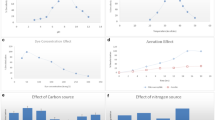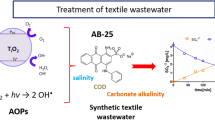Abstract
Sulfate is a key component in the textile industry and sulfate-reducing conditions could enhance dye reduction in the treatment of textile industry wastewater. In this study, a sulfidogenic up flow anaerobic reactors fed with different organic substrates (ethanol and acetate) were operated to treat textile wastewater and Remazol Brilliant Violet 5R was used as a model dyestuff. The reactors were operated for 192 days at 7 operational periods at 1 day HRT. Throughout the study, 2000 mg/L SO42− and 1340–1540 mg/L COD were added to the feed, corresponding to COD/SO42− ratios of 0.67 and 0.77, respectively. Remazol Brilliant Violet 5R was added to feed at a concentration of 50 mg/L on day 148 and its concentration was gradually increased to 1000 mg/L. The maximum dye removal rate was over 990 mg/(L.d) for both reactors. Although high-rate dye removal was achieved, an increase in the dye concentration resulted in a decreased sulfate reduction and COD oxidation for both reactors. In addition to the continuous process, biotic and abiotic batch reactors were operated to identify the dye removal mechanism. Batch reactors showed that biogenic sulfide produced in the sulfate reduction can be used to reduce Remazol Brilliant Violet 5R. Batch reactors also indicated that although abiotic sulfide-based Remazol Brilliant Violet 5R reduction is possible, the presence of microorganisms increased its reduction rate.





Similar content being viewed by others
References
Al-Tohamy R, Ali SS, Li F et al (2022) A critical review on the treatment of dye-containing wastewater: ecotoxicological and health concerns of textile dyes and possible remediation approaches for environmental safety. Ecotoxicol Environ Saf 231:113160
Albahnasawi A, Yüksel E, Gürbulak E, Duyum F (2020) Fate of aromatic amines through decolorization of real textile wastewater under anoxic-aerobic membrane bioreactor. J Environ Chem Eng 8:104226
APHA (2005) Standard Methods for the Examination of Water and Wastewater. Washington DC, USA
Arslan M, Sayin S, Yilmaz M (2013) Removal of carcinogenic azo dyes from water by new cyclodextrin-immobilized iron oxide magnetic nanoparticles. Water Air Soil Pollut 224:1–9
Aydin MI, Yuzer B, Ongen A et al (2018) Comparison of ozonation and coagulation decolorization methods in real textile wastewater. Desalin Water Treat 103:1–10. https://doi.org/10.5004/dwt.2018.21880
Barathi S, Karthik C, Nadanasabapathi S, Padikasan IA (2020) Biodegradation of textile dye Reactive Blue 160 by Bacillus firmus (Bacillaceae: Bacillales) and non-target toxicity screening of their degraded products. Toxicol Rep 7:16–22
Bayburt C, Karaduman AB, Gürsu BY et al (2020) Decolourization and detoxification of textile dyes by Lentinus arcularius in immersion bioreactor scale. Int J Environ Sci Technol 17:945–958
Bayrakdar A, Sahinkaya E, Gungor M et al (2009) Performance of sulfidogenic anaerobic baffled reactor (ABR) treating acidic and zinc-containing wastewater. Bioresour Technol 100:4354–4360. https://doi.org/10.1016/j.biortech.2009.04.028
Bekmezci OK, Ucar D, Kaksonen AH, Sahinkaya E (2011) Sulfidogenic biotreatment of synthetic acid mine drainage and sulfide oxidation in anaerobic baffled reactor. J Hazard Mater 189:670–676. https://doi.org/10.1016/j.jhazmat.2011.01.087
Cervantes FJ, Enriquez JE, Mendoza-Hernandez MR et al (2006) The role of sulphate reduction on the reductive decolorization of the azo dye reactive orange 14. Water Sci Technol 54:171–177
Cirik K, Dursun N, Sahinkaya E, Çinar Ö (2013a) Effect of electron donor source on the treatment of Cr(VI)-containing textile wastewater using sulfate-reducing fluidized bed reactors (FBRs). Bioresour Technol 133:414–420. https://doi.org/10.1016/j.biortech.2013.01.064
Cirik K, Kitis M, Cinar O (2013b) The effect of biological sulfate reduction on anaerobic color removal in anaerobic–aerobic sequencing batch reactors. Bioprocess Biosyst Eng 36:579–589
Cord-ruwisch R (1985) A quick method for the determination of dissolved and precipitated sulfides in cultures of sulfate-reducing bacteria. J Microbiol Methods 4:33–36
dos Santos AB, Cervantes FJ, van Lier JB (2007) Review paper on current technologies for decolourisation of textile wastewaters: perspectives for anaerobic biotechnology. Bioresour Technol 98:2369–2385. https://doi.org/10.1016/j.biortech.2006.11.013
Eswaramoorthi S, Dhanapal K, Chauhan D (2008) Advanced in textile waste water treatment: The case for UV-ozonation and membrane bioreactor for common effluent treatment plants in Tirupur, Tamil Nadu, India. Environ with People’s Involv Co-ord India Coimbatore, India
Ghaly AE, Ananthashankar R, Alhattab M, Ramakrishnan VV (2014) Production, characterization and treatment of textile effluents: a critical review. J Chem Eng Process Technol 5:1–19
Gita S, Hussan A, Choudhury TG (2017) Impact of textile dyes waste on aquatic environments and its treatment. Environ Ecol 35:2349–2353
Hossen MZ, Hussain ME, Hakim A et al (2019) Biodegradation of reactive textile dye Novacron Super Black G by free cells of newly isolated Alcaligenes faecalis AZ26 and Bacillus spp obtained from textile effluents. Heliyon 5:e02068
Huang R, Liu Z, Zhou X et al (2015) Research on treatment of printing and dyeing wastewater by hybrid anaerobic baffled reactor. Desalin Water Treat 54:590–597. https://doi.org/10.1080/19443994.2014.891463
Hussain A, Hasan A, Javid A, Qazi JI (2016) Exploited application of sulfate-reducing bacteria for concomitant treatment of metallic and non-metallic wastes: a mini review. 3 Biotech 6:1–10. https://doi.org/10.1007/s13205-016-0437-3
Hussein FH (2013) Chemical properties of treated textile dyeing wastewater. Asian J Chem 25:9393–9400
Jagaba AH, Kutty SRM, Isa MH, et al (2022) Effect of environmental and operational parameters on sequential batch reactor systems in dye degradation. In: Dye biodegradation, mechanisms and techniques. Springer, pp 193–225
Jonstrup M, Kumar N, Murto M, Mattiasson B (2011) Sequential anaerobic-aerobic treatment of azo dyes: decolourisation and amine degradability. Desalination 280:339–346. https://doi.org/10.1016/j.desal.2011.07.022
Liamleam W, Annachhatre AP (2007) Electron donors for biological sulfate reduction. Biotechnol Adv 25:452–463. https://doi.org/10.1016/j.biotechadv.2007.05.002
Miran W, Jang J, Nawaz M et al (2018) Sulfate-reducing mixed communities with the ability to generate bioelectricity and degrade textile diazo dye in microbial fuel cells. J Hazard Mater 352:70–79. https://doi.org/10.1016/j.jhazmat.2018.03.027
Mokhtari P, Ghaedi M, Dashtian K et al (2016) Removal of methyl orange by copper sulfide nanoparticles loaded activated carbon: kinetic and isotherm investigation. J Mol Liq 219:299–305
Popli S, Patel UD (2015) Destruction of azo dyes by anaerobic–aerobic sequential biological treatment: a review. Int J Environ Sci Technol 12:405–420. https://doi.org/10.1007/s13762-014-0499-x
Rasool K, Shahzad A, Lee DS (2016) Exploring the potential of anaerobic sulfate reduction process in treating sulfonated diazo dye: microbial community analysis using bar-coded pyrosequencing. J Hazard Mater 318:641–649. https://doi.org/10.1016/j.jhazmat.2016.07.052
Rasool K, Woo SH, Lee DS (2013) Simultaneous removal of COD and Direct Red 80 in a mixed anaerobic sulfate-reducing bacteria culture. Chem Eng J 223:611–616
Roberts PA, Loxham SJG, Poucher SM et al (2002) Bicarbonate-induced alkalosis augments cellular acetyl group availability and isometric force during the rest-to-work transition in canine skeletal muscle. Exp Physiol 87:489–498
Sahinkaya E, Gunes FM, Ucar D, Kaksonen AH (2011) Sulfidogenic fluidized bed treatment of real acid mine drainage water. Bioresour Technol 102:683–689. https://doi.org/10.1016/j.biortech.2010.08.042
Sahinkaya E, Isler E, Yurtsever A, Coban I (2019) Sulfidogenic treatment of acid mine drainage using anaerobic membrane bioreactor. J Water Process Eng 31:100816. https://doi.org/10.1016/j.jwpe.2019.100816
Sandhya S, Padmavathy S, Swaminathan K et al (2005) Microaerophilic–aerobic sequential batch reactor for treatment of azo dyes containing simulated wastewater. Process Biochem 40:885–890
Saratale RG, Saratale GD, Chang JS, Govindwar SP (2011) Bacterial decolorization and degradation of azo dyes: A review. J Taiwan Inst Chem Eng 42:138–157. https://doi.org/10.1016/j.jtice.2010.06.006
Shamraiz U, Hussain RA, Badshah A et al (2016) Functional metal sulfides and selenides for the removal of hazardous dyes from Water. J Photochem Photobiol B Biol 159:33–41
Stolz A (2001) Basic and applied aspects in the microbial degradation of azo dyes. Appl Microbiol Biotechnol 56:69–80. https://doi.org/10.1007/s002530100686
Uçar D (2017) Sequential precipitation of heavy metals using sulfide-laden bioreactor effluent in a ph controlled system. Miner Process Extr Metall Rev. https://doi.org/10.1080/08827508.2017.1281131
US EPA (1986) Method 9038-sulfate (turbidimetric). In: (US Environ. Prot. Agency) Washington, DC, USA. https://www.epa.gov/sites/production/files/2015-12/documents/9038.pdf. Accessed 21 Jan 2018
Van Der Zee FP, Bisschops IAE, Blanchard VG et al (2003) The contribution of biotic and abiotic processes during azo dye reduction in anaerobic sludge. Water Res 37:3098–3109
Yaseen DA, Scholz M (2019) Textile dye wastewater characteristics and constituents of synthetic effluents: a critical review. Int J Environ Sci Technol 16:1193–1226
Yildiz M, Yilmaz T, Arzum CS, Yurtsever A, Kaksonen AH, Ucar D (2019) Sulfate reduction in acetate-and ethanol-fed bioreactors: acidic mine drainage treatment and selective metal recovery. Miner Eng 133:52–59
Yurtsever A, Basaran E, Ucar D (2020) Process optimization and filtration performance of an anaerobic dynamic membrane bioreactor treating textile wastewaters. J Environ Manage 273:111114. https://doi.org/10.1016/j.jenvman.2020.111114
Yurtsever A, Sahinkaya E, Aktaş Ö et al (2015) Performances of anaerobic and aerobic membrane bioreactors for the treatment of synthetic textile wastewater. Bioresour Technol 192:564–573. https://doi.org/10.1016/j.biortech.2015.06.024
Zeng Q, Wang Y, Zan F, Khanal SK, Hao T (2021) Biogenic sulfide for azo dye decolorization from textile dyeing wastewater. Chemosphere 283:131158
Zollinger H (2003) Color chemistry: syntheses, properties, and applications of organic dyes and pigments. John Wiley and Sons
Acknowledgments
Authors thank to Harran University.
Author information
Authors and Affiliations
Contributions
TY contributed to investigation, software, writing—original draft; MY contributed to methodology; CŞAY contributed to validation; HUA contributed to investigation; DU contributed to supervision, writing both original draft and review and editing.
Corresponding author
Ethics declarations
Conflict of interest
Authors declare no conflict of interest.
Ethical approval
This article does not contain any studies with human participants performed by any of the authors.
Additional information
Editorial responsibility: Anna Grobelak.
Rights and permissions
Springer Nature or its licensor (e.g. a society or other partner) holds exclusive rights to this article under a publishing agreement with the author(s) or other rightsholder(s); author self-archiving of the accepted manuscript version of this article is solely governed by the terms of such publishing agreement and applicable law.
About this article
Cite this article
Yilmaz, T., Yildiz, M., Arzum Yapici, C.Ş. et al. Direct and sulfide mediated treatment of textile effluents in acetate and ethanol-fed upflow sulfidogenic bioreactors. Int. J. Environ. Sci. Technol. 20, 7177–7188 (2023). https://doi.org/10.1007/s13762-023-04774-3
Received:
Revised:
Accepted:
Published:
Issue Date:
DOI: https://doi.org/10.1007/s13762-023-04774-3




